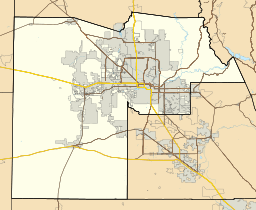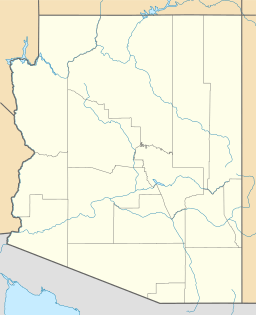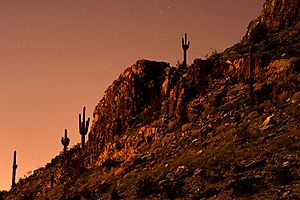Piestewa Peak facts for kids
Piestewa Peak (pronounced py-ES-tə-wah), also known as Vainom Do'ag, is a famous mountain in Phoenix, Arizona. It stands at 2,610 feet (796 m) tall, making it the second highest point in the Phoenix Mountains. Only Camelback Mountain is taller in this range. Piestewa Peak is part of the Piestewa Peak Recreation Area, which is inside the larger Phoenix Mountains Preserve. The mountain is named after Army Specialist Lori Ann Piestewa. She was the first known Native American woman to die in combat for the U.S. military, and the first female soldier killed in action during the 2003 Iraq War.
Quick facts for kids Piestewa Peak |
|
|---|---|
| Vainom Do'ag | |
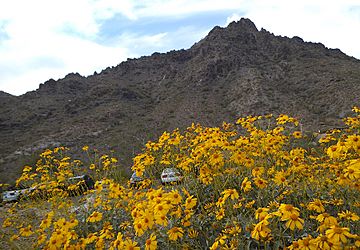
Brittlebush near the base of Piestewa Peak
|
|
| Highest point | |
| Elevation | 2,610 ft (796 m) NAVD 88 |
| Prominence | 1,176 ft (358 m) |
| Geography | |
| Location | Maricopa County, Arizona, U.S. |
| Parent range | Phoenix Mountains |
| Topo map | USGS Sunnyslope |
| Geology | |
| Age of rock | Precambrian |
| Mountain type | Schist |
| Climbing | |
| Easiest route | Walk up, class 1s3 |
Contents
How Piestewa Peak Got Its Name
For a long time, since at least 1910, this mountain was called Squaw Peak. Other old names included Squaw Tit Mountain, Phoenix Mountain, and Vainom Do'ag. Vainom Do'ag is the name given by the Pima people, who are a Native American tribe.
Why the Name Changed
The word "squaw" is considered offensive by many people, especially Native Americans. Because of this, many groups tried to change the mountain's name over the years. Starting in 1992, State Representative Jack Jackson, who was a Navajo, tried every year to pass a law to change the name. These attempts often led to strong debates in Arizona.
In 1997, a youth group from the American Indian Movement asked the State Board on Geographic and Historic Names to change the name. They suggested "Iron Mountain," which is the English meaning of the Pima name. The board studied the request for almost a year. In 1998, they decided that it was unclear if Vainom Do'ag referred to this mountain or another nearby peak. So, they rejected the request but said they would consider other name changes.
Honoring a Hero
The United States Board on Geographic Names has a rule about changing names that use the word "squaw." They will consider changes if local groups approve them. They also suggest choosing new names that honor Native American women or their culture.
In 2003, Arizona's new Governor, Janet Napolitano, asked the state board to rename the mountain for Lori Piestewa. Lori Piestewa was a brave soldier who had died in the Iraq War earlier that year. The Governor's request was successful, but it also caused some discussion.
One reason for the discussion was that the Governor's request broke a rule. Usually, a geographic place cannot be renamed until five years after a person's death. Lori Piestewa had just died. The director of the Arizona State Board on Geographic and Historic Names, Tim Norton, refused to put the request on the board's meeting list because of this rule.
Despite the rule, the state board approved the name change to Piestewa Peak on April 17, 2003. This was less than a month after Lori Piestewa's death. The U.S. Board on Geographic Names, however, still refused to accept the change at that time, sticking to their own five-year waiting rule.
Final Approval
Five years later, in 2008, the U.S. Board on Geographic Names agreed to look at the request again. They also thought about other possible names, like Swilling Peak. In the end, the national board voted to approve the name change to Piestewa Peak. They also said that the old name, Squaw Peak, could still be used as a secondary reference in some publications.
Nature at Piestewa Peak
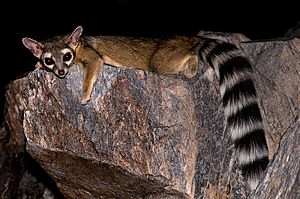
Piestewa Peak is a relatively young landform, meaning it was formed about 14 million years ago. However, the rocks it is made of are much older. The mountain is mostly made of a type of rock called schist.
Plants of the Sonoran Desert
The plants around Piestewa Peak are typical of the lower Sonoran Desert. You can find almost all kinds of Arizona cactus here. These include saguaro, barrel, hedgehog, pincushion, jumping cholla, and prickly pear cacti.
You will also see many trees and colorful shrubs. Some common ones are palo verde, mesquite, ironwood trees, creosote, ocotillo, brittlebush, desert lavender, and giant sage shrubs.
In early spring, many wildflowers bloom, making the desert colorful. You might see bright yellow Mexican gold poppies and brittlebush. There are also purple lupine and scorpionweed, and orange desert globemallow. Other flowers like fiddleneck and bladderpod also grow here, along with the many types of flowering cacti.
Animals of the Preserve
Many different kinds of reptiles live in the preserve. These include the gila monster, horned lizard, chuckwalla, and the western diamondback rattlesnake.
The mammal population includes animals like coyotes, bobcats, jackrabbits, cottontail rabbits, ground squirrels, and kit foxes.
Several bird species also make their home here. You might spot turkey vultures, mockingbirds, cactus wrens, Gambel's quail, and different kinds of owls and hawks.
Hiking Piestewa Peak
The Piestewa Peak Summit Trail is very popular. Hikers gain about 1,208 feet (368 m) in elevation over 1.2 miles (1.9 km). Thousands of people climb this trail every week for exercise, amazing views, or a family adventure.
Summit Trail Challenges
Many hikers do not reach the very top because the trail is harder than it looks. This is especially true in the summer when temperatures can be over 100 °F (40 °C). There is no water available on the trail itself. Dehydration is a serious problem for hikers who are not prepared. You can find water only at the start of the trail and at a few rest stops along Squaw Peak Road.
The hike usually takes between 25 and 60 minutes in good weather. Hot and sunny conditions can make the hike take twice as long. If you are new to hiking, plan for 60 minutes to go up slowly and 40 minutes to come down.
The path is mostly easy to follow. However, there are about four spots where it can be confusing, and you might need to look around for the correct route. Some parts of the trail are very steep and do not have guard rails, making them technically challenging.
Views from the Top
From the summit, on a clear day, you can see many other mountains and landmarks. These include Pinnacle Peak, the McDowell Mountains, Four Peaks, the Superstition Mountains, Tabletop Mountain, the Sierra Estrella, Woolsey Peak, the White Tank Mountains, the Harquahala Mountains, the Papago Mountains, the Hieroglyphic Mountains, and the Bradshaw Mountains.
Other Trails and Rules
The Phoenix Mountain Preserve has about fifteen miles of trails that connect to each other. These trails range from easy to difficult.
There are some important differences in rules between the Piestewa Peak Summit Trail and the rest of the preserve's trails:
- Most trails in the preserve allow horseback riding, biking, and foot traffic, including dogs.
- The Piestewa Peak Summit Trail allows only foot traffic. No bicycles, dogs, or horses are allowed on this specific trail.
- The larger trail system is generally open from sunrise to sunset.
- The Piestewa Peak Summit Trail is open from sunrise until 11:00 PM. This unique late-night access, along with its closeness to city lights and light-colored rock, makes it a popular spot for night hikes.


